
Medical Image Computing and Computer Assisted Intervention – MICCAI 2020
Springer International Publishing (Verlag)
978-3-030-59721-4 (ISBN)
The seven-volume set LNCS 12261, 12262, 12263, 12264, 12265, 12266, and 12267 constitutes the refereed proceedings of the 23rd International Conference on Medical Image Computing and Computer-Assisted Intervention, MICCAI 2020, held in Lima, Peru, in October 2020. The conference was held virtually due to the COVID-19 pandemic.
The 542 revised full papers presented were carefully reviewed and selected from 1809 submissions in a double-blind review process. The papers are organized in the following topical sections:
Part I: machine learning methodologies
Part II: image reconstruction; prediction and diagnosis; cross-domain methods and reconstruction; domain adaptation; machine learning applications; generative adversarial networks
Part III: CAI applications; image registration; instrumentation and surgical phase detection; navigation and visualization; ultrasound imaging; video image analysis
Part IV: segmentation; shape models and landmark detection
Part V: biological, optical, microscopic imaging; cell segmentation and stain normalization; histopathology image analysis; opthalmology
Part VI: angiography and vessel analysis; breast imaging; colonoscopy; dermatology; fetal imaging; heart and lung imaging; musculoskeletal imaging
Part VI: brain development and atlases; DWI and tractography; functional brain networks; neuroimaging; positron emission tomography
Biological, Optical, Microscopic Imaging.- Channel Embedding for Informative Protein Identification from Highly Multiplexed Images.- Demixing Calcium Imaging Data in C. elegans via Deformable Non-negative Matrix Factorization.- Automated Measurements of Key Morphological Features of Human Embryos for IVF.- A Novel Approach to Tongue Standardization and Feature Extraction.- Patch-based Non-Local Bayesian Networks for Blind Confocal Microscopy Denoising.- Attention-guided Quality Assessment for Automated Cryo-EM Grid Screening.- MitoEM Dataset: Large-scale 3D Mitochondria Instance Segmentation from EM Images.- Learning Guided Electron Microscopy with Active Acquisition.- Neuronal Subcompartment Classification and Merge Error Correction.- Microtubule Tracking in Electron Microscopy Volumes.- Leveraging Tools from Autonomous Navigation for Rapid, Robust Neuron Connectivity.- Statistical Atlas of C.elegans Neurons.- Probabilistic Segmentation and Labeling of C. elegans Neurons.- Segmenting Continuous but Sparsely-Labeled Structures in Super-Resolution Microscopy Using Perceptual Grouping.- DISCo: Deep learning, Instance Segmentation, and Correlations for cell segmentation in calcium imaging.- Isotropic Reconstruction of 3D EM Images with Unsupervised Degradation Learning.- Background and illumination correction for time-lapse microscopy data with correlated foreground.- Joint Spatial-Wavelet Dual-Stream Network for Super-Resolution.- Towards Neuron Segmentation from Macaque Brain Images: A Weakly Supervised Approach.- 3D Reconstruction and Segmentation of Dissection Photographs for MRI-free Neuropathology.- DistNet: Deep Tracking by displacement regression: application to bacteria growing in the Mother Machine.- A weakly supervised deep learning approach for detecting malaria and sickle cell anemia in blood films.- Imaging Scattering Characteristics of Tissue in Transmitted Microscopy.- Attention based multiple instance learning for classification of blood cell disorders.- A generative modeling approach for interpreting population-level variability in brain structure.- Processing-Aware Real-Time Rendering for Optimized Tissue Visualization in Intraoperative 4D OCT.- Cell Segmentation and Stain Normalization.- Boundary-assisted Region Proposal Networks for Nucleus Segmentation.- BCData: A Large-Scale Dataset and Benchmark for Cell Detection and Counting.- Weakly-Supervised Nucleus Segmentation Based on Point Annotations: A Coarse-to-Fine Self-Stimulated Learning Strategy.- Structure Preserving Stain Normalization of Histopathology Images Using Self Supervised Semantic Guidance.- A Novel Loss Calibration Strategy for Object Detection Networks Training on Sparsely Annotated Pathological Datasets.- Histopathological Stain Transfer Using Style Transfer Network With Adversarial Loss.- Instance-aware Self-supervised Learning for Nuclei Segmentation.- StyPath: Style-Transfer Data Augmentation For Robust Histology Image Classification.- Multimarginal Wasserstein Barycenter for Stain Normalization and Augmentation.- Corruption-Robust Enhancement of Deep Neural Networks for Classification of Peripheral Blood Smear Images.- Multi-Field of View Aggregation and Context Encoding for Single-Stage Nucleus Recognition.- Self-Supervised Nuclei Segmentation in Histopathological Images Using Attention.- FocusLiteNN: High Efficiency Focus Quality Assessment for Digital Pathology.- Histopathology Image Analysis.- Pairwise Relation Learning for Semi-supervised Gland Segmentation.- Ranking-Based Survival Prediction on Histopathological Whole-Slide Images.- Renal Cell Carcinoma Detection and Subtyping with Minimal Point-Based Annotation in Whole-Slide Images.- Censoring-Aware Deep Ordinal Regression for Survival Prediction from Pathological Images.- Tracing Diagnosis Paths on Histopathology WSIs for Diagnostically Relevant Case Recommendation.- Weakly supervised multiple instance learning histopathological tumor segmentation.- Divide-and-Rule: Self-Supervised Learning for Survival Analysis in Colorectal Cancer.- Microscopic fine-grained instance classification through deep attention.- A Deformable CRF Model for Histopathology Whole-slide Image Classification.- Deep Active Learning for Breast Cancer Segmentation on Immunohistochemistry Images.- Multiple Instance Learning with Center Embeddings for Histopathology Classification.- Graph Attention Multi-instance Learning for Accurate Colorectal Cancer Staging.- Deep Interactive Learning: An Efficient Labeling Approach for Deep Learning-Based Osteosarcoma Treatment Response Assessment.- Modeling Histological Patterns for Differential Diagnosis of Atypical Breast Lesions.- Foveation for Segmentation of Mega-pixel Histology Images.- Multimodal Latent Semantic Alignment for Automated Prostate Tissue Classification and Retrieval.- Opthalmology.- GREEN: a Graph REsidual rE-ranking Network for Grading Diabetic Retinopathy.- Combining Fundus Images and Fluorescein Angiographyfor Artery/Vein Classification Using the Hierarchical Vessel Graph Network.- Adaptive Dictionary Learning Based Multimodal Branch Retinal Vein Occlusion Fusion.- TR-GAN: Topology Ranking GAN with Triplet Loss for Retinal Artery/Vein Classification.- DeepGF: Glaucoma Forecast Using Sequential Fundus Images.- Single-Shot Retinal Image Enhancement Using Deep Image Prior.- Robust Layer Segmentation against Complex Retinal Abnormalities for en face OCTA Generation.- Anterior Segment Eye Lesion Segmentation with Advanced Fusion Strategies and Auxiliary Tasks.- Cost-Sensitive Regularization for Diabetic Retinopathy Grading from Eye Fundus Images.- Disentanglement Network for Unpsupervised Speckle Reduction of Optical Coherence Tomography Images.- Positive-Aware Lesion Detection Network with Cross-scale Feature Pyramid for OCT Images.- Retinal Layer Segmentation Reformulated as OCT Language Processing.- Reconstruction and Quantification of 3D Iris Surface for Angle-Closure Glaucoma Detection in Anterior Segment OCT.- Open-Appositional-Synechial Anterior Chamber Angle Classification in AS-OCT Sequences.- A Macro-Micro Weakly-supervised Framework for AS-OCT Tissue Segmentation.- Macular Hole and Cystoid Macular Edema Joint Segmentation by Two-Stage Network and Entropy Minimization.- Retinal Nerve Fiber Layer Defect Detection With Position Guidance.- An Elastic Interaction Based-Loss Function for Medical Image Segmentation.- Retinal Image Segmentation with a Structure-Texture Demixing Network.- BEFD: Boundary Enhancement and Feature Denoising for Vessel Segmentation.- Boosting Connectivity in Retinal Vessel Segmentation via a Recursive Semantics-Guided Network.- RVSeg-Net: an Efficient Feature Pyramid Cascade Network for Retinal Vessel Segmentation-
| Erscheinungsdatum | 04.10.2020 |
|---|---|
| Reihe/Serie | Image Processing, Computer Vision, Pattern Recognition, and Graphics | Lecture Notes in Computer Science |
| Zusatzinfo | XXXVII, 811 p. 11 illus. |
| Verlagsort | Cham |
| Sprache | englisch |
| Maße | 155 x 235 mm |
| Gewicht | 1282 g |
| Themenwelt | Informatik ► Grafik / Design ► Digitale Bildverarbeitung |
| Informatik ► Theorie / Studium ► Künstliche Intelligenz / Robotik | |
| Schlagworte | Applications • Artificial Intelligence • color image processing • Computer Science • computer vision • conference proceedings • Deep learning • Digital image • Image Analysis • image matching • Image Processing • Image Quality • image reconstruction • Image Segmentation • Imaging Systems • Informatics • machine learning • Medical Images • Neural networks • pattern recognition • reference image • Research • segmentation methods • Signal Processing |
| ISBN-10 | 3-030-59721-0 / 3030597210 |
| ISBN-13 | 978-3-030-59721-4 / 9783030597214 |
| Zustand | Neuware |
| Haben Sie eine Frage zum Produkt? |
aus dem Bereich


